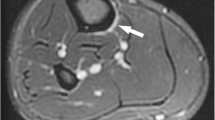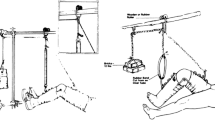Abstract
Purpose
This study was conducted to compare traditional surgery and surgery assisted by 3D printing technology in the treatment of tibial plateau fractures. In addition, we also investigated the effect of 3D printing technology on the communication between doctors and patients.
Methods
Seventy two patients with tibial plateau fractures were enrolled in the study from April 2014 to October 2015. They were divided into two groups: 34 cases of 3D model group, 38 cases of traditional surgery group. The individual models were used to simulate the surgical procedures and carry out the surgery according to plan. Operation time, blood loss, and number of intra-operative fluoroscopy were recorded. Through the follow-up, the recovery of patients were observed. Besides, we designed questionnaires to verify the satisfaction for both surgeons and patients.
Results
The average operation time, average amount of blood loss, and number of intra-operative fluoroscopy for 3D model group was 85.2±0.9 minutes, 186.3± 5.5ml, 5.3± 0.2 times, and for traditional surgery group was 99.2±1.0 minutes, 216.2 ±6.9 ml,7.1 ± 0.2 times respectively. There was statistically significant difference between the traditional surgery group and 3D model group (P < 0.05). Via follow-up, we can see that the 3D printing group has a better clinical efficacy. The average score of the questionnaires to Patient and doctors were 7.3 ± 0.1 points and 8.5± 0.1 points respectively.
Conclusion
This study suggested the clinical feasibility of 3D printing technology in treatment of tibial plateau fractures.



Similar content being viewed by others
References
Dirschl DR, Dawson PA (2004) Injury severity assessment in tibial plateau fractures. Clin Orthop Relat R 423(423):85–92. doi:10.1097/01.blo.0000132626.13539.4b
Morris BJ, Unger RZ, Archer KR, Mathis SL, Perdue AM, Obremskey WT (2013) Risk factors of infection after orif of bicondylar tibial plateau fractures. J Orthop Trauma 27(9):196–200. doi:10.1097/BOT.0b013e318284704e
Stannard JP, Lopez R, Volgas D (2010) Soft tissue injury of the knee after tibial plateau fractures. J Knee Surg 23(4):187–192. doi:10.1055/s-0030-1268694
Ali AM, Elshafie M, Willett KM (2002) Failure of fixation of tibial plateau fractures. J Orthop Trauma 16(5):323–329
Barei DP, Nork SE, Mills WJ, Henley MB, Benirschke SK (2004) Complications associated with internal fixation of high-energy bicondylar tibial plateau fractures utilizing a two-incision technique. J Orthop Trauma 18(10):649–657
Bishop J, Agel J, Dunbar R (2012) Predictive factors for knee stiffness after periarticular fracture: a case-control study. J Bone Joint Surg Am 94(20):1833–1838. doi:10.2106/jaJS.K.00659
Yang L, Shang XW, Fan JN et al (2016) Application of 3D printing in the surgical planning of trimalleolar fracture and doctor-patient communication. Biomed Res Int 2016(420):1–5
Chung KJ, Huang B, Choi CH et al (2015) Utility of 3D printing for complex distal tibial fractures and malleolar avulsion fractures: technical tip. Foot Ankle Int 36(12):1504
Shuang F, Hu W, Shao Y et al (2016) Treatment of intercondylar humeral fractures with 3D-printed osteosynthesis plates. Medicine 95(3):e2461
Bagaria V, Deshpande S, Rasalkar DD, Kuthe A, Paunipagar BK (2011) Use of rapid prototyping and three-dimensional reconstruction modeling in the management of complex fractures. use of rapid prototyping and three-dimensional reconstruction modeling in the management of complex fractures. Eur J Radiol 80(3):814–820. doi:10.1016/j.ejrad.2010.10.007
Mellema JJ, Doornberg JN, Molenaars RJ et al (2016) Tibial plateau fracture characteristics: reliability and diagnostic accuracy. J Orthop Trauma 30(5):e144
Bali K, Walker P, Bruce W (2012) Custom-fit total knee arthroplasty: our initial experience in 32 knees. J Arthroplasty 27(6):1149–1154. doi:10.1016/j.arth.2011.12.006
Carrera I, Gelber P E, Chary G, et al. (2016) Fixation of a split fracture of the lateral tibial plateau with a locking screw plate instead of cannulated screws would allow early weight bearing: a computational exploration. Int Orthopaed: 1-–7
Wang L, Yu S, Lin CS et al (2016) The application of a three-column internal fixation system with anatomical locking plates on comminuted fractures of the tibial plateau. Int Orthop 40(7):1509–1514
Ehlinger M, Adamczewski B, Adam P, et al. (2015) Comparison of the pre-shaped anatomical locking plate of 3.5 mm versus 4.5 mm for the treatment of tibial plateau fractures. Int Orthopaed: 1–7
Benum P, Aamodt AL (2010) Customised femoral stems in osteopetrosis and the development of a guiding system for the preparation of an intramedullary cavity: a report of two cases. Bone Joint J 92(9):1303–1305. doi:10.1302/0301-620X.92B9
Hahn DM (2004) Current principles of treatment in the clinical practice of articular fractures. Clin Orthop Relat Res 423(423):27–32. doi:10.1097/01.blo.0000131234.91264.9e
Wu XB, Wang JQ, Zhao CP, Sun X, Shi Y, Zhang ZA et al (2015) Printed three-dimensional anatomic templates for virtual pre-operative planning before reconstruction of old pelvic injuries: initial results. Chin Med J 128(4):477–482. doi:10.4103/0366-6999.151088
Cockburn J, Walters WA (1999) Communication between doctors and patients. Curr Obstet Gynaecol 9(1):34–40
Dyche L (2007) Interpersonal skill in medicine: the essential partner of verbal communication. J Gen Intern Med 22(7):1035–1039. doi:10.1007/s11606-007-0153-0
Bizzotto N, Tami I, Tami A, Spiegel A, Romani D, Corain M et al (2016) 3d printed models of distal radius fractures. Injury 47(4):976–978. doi:10.1016/j.injury.2016.01.013
Acknowledgements
This work is supported by a grant from National Nature Foundation of China (Grant No.81472146), and Wenzhou Science and Technology Bureau Foundation. (Grant No. Y20160135).
Publisher’s Note
Springer Nature remains neutral with regard to jurisdictional claims in published maps and institutional affiliations.
Author information
Authors and Affiliations
Corresponding authors
Ethics declarations
All procedures performed in studies involving human participants were in accordance with the ethical standards of the institutional and/or national research committee and with the 1964 Helsinki declaration and its later amendments or comparable ethical standards.
Funding
This study was funded by National Nature Foundation of China (Grant No.81472146), and Wenzhou Science and Technology Bureau Foundation (Grant No. Y20160135).
Conflict of interest
The authors declare that they have no conflict of interest.
Rights and permissions
About this article
Cite this article
Lou, Y., Cai, L., Wang, C. et al. Comparison of traditional surgery and surgery assisted by three dimensional printing technology in the treatment of tibial plateau fractures. International Orthopaedics (SICOT) 41, 1875–1880 (2017). https://doi.org/10.1007/s00264-017-3445-y
Received:
Accepted:
Published:
Issue Date:
DOI: https://doi.org/10.1007/s00264-017-3445-y




